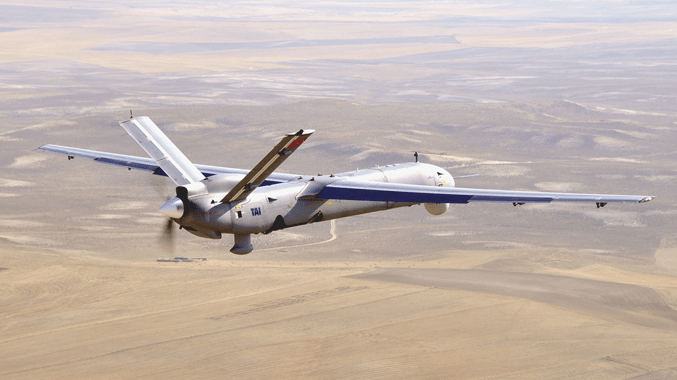By Justin Vela in Istanbul

Turkey is moving up in defence manufacturing with the commercial development of the ANKA, its first domestically-made drone (pictured).
It’s the product of an industry that’s largely state-owned but one that is expanding its $14bn-a-year revenues, and creating investment opportunities through privatisation. First for a likely stock market launch is ANKA’s maker, Turkish Aerospace Industries (TAI), the second largest company in the sector.
Like most Turkish defence contractors, TAI is a subsidiary of the country’s Armed Forces Foundation (TSKGV). It is expected to be listed on the Istanbul Stock Exchange (ISE) later this year, according to Arda Mevlutoglu, a Turkish defence analyst, who says the pioneering sale could pave the way for others.
“Going [public] is part of a wider strategic plan to make TAI a global player,” Mevlutoglu said. “If the formula works well, it may be applied to other major contractors as well.”
TAI didn’t respond to a request for comment in time for publication. The ANKA unmanned aerial vehicle (UAV) is one of TAI’s latest developments, with a 56-foot wingspan, a top speed of 75 knots per hour, and a maximum altitude of 30,000 feet.
The Anka completed military testing in late January and is set for serial production. Turkey aims to export the drone around the region, with the Egyptian government reportedly signing an agreement last November to buy 10 of the drones.
On March 6, Turkey’s President Abdullah Gul showed the ANKA to Jordan’s King Abdullah, along with other military products, such as the T-129 “ATAK” combat helicopter, a $3.2bn joint project between TAI and the Anglo-Italian helicopter company AgustaWestland.
In 2012, Turkey exported about $1.2bn worth of defence equipment, a 35.7 per cent rise over 2011. The main export destinations were the US ($490m), United Arab Emirates ($101m), and Saudi Arabia ($99m). The industry is aiming for $2bn in exports by 2016.
Mevlutoglu noted that Turkey’s Undersecretary for Defense Industries (SSM) has a regional office in Riyadh, Saudi Arabia “for overseeing and coordinating export activities in the region.”
In February 2013, Turkish missile manufacturer Roketsan signed a $196.2m deal to provide the UAE military with its Cirit laser-guided rocket system. This is the first foreign sale of Cirit, which is billed as a relatively low-cost precision strike system equipped with 70mm rockets that have a range of eight kilometers.
“Turkey is trying to develop low-cost highly reliable weapons that aren’t as expensive as the US systems, but that match the capabilities,” said Aaron Stein, a researcher at Istanbul’s Center for Economics and Foreign Policy Studies. “That allows Turkey to fill a niche market. It will take time, but…it is state policy to do this.”
Roketsan is also partnered with US-based arms manufacturer Lockheed Martin to produce canisters for its PAC-3 missile.
Other Turkish weapons include the Altay tank, a $400m project produced by Otokar, a subsidiary of Turkey’s Koc Holding, the country’s largest listed conglomerate. South Korea’s Hyundai Rotem and Turkey’s Roketsan and Aselsan, a publicly-listed military communications and electronics company, are among the project’s sub-contractors. Serial production is expected to start in 2015.
Otokar also produces the Cobra armored vehicle, which is currently exported to a number of countries around the world, including Azerbaijan, Bahrain, and Pakistan.
Turkey’s desire to foster its domestic defence industry dates back to the 1980′s and is partly aimed at decreasing dependence on buying “off the shelf” military goods from the US, Stein said.
“It’s a platform for Turkey to develop high-technology exports.”
The increased exports will also help ease Turkey’s current account deficit, which is expected to be 7-8 per cent of gross domestic product (GDP) in 2013.
However, the increase in arms exports has raised some concerns about weapons proliferation in the region. The US Congress has long blocked the sale of drones to Turkey, citing incidents such as the accidental killing of 40 Kurdish civilians from the southern town of Uludere by the Turkish Air Force of in December 2011.
With the ANKA headed for serial production, TAI has already begun developing an armed version of the drone called the ANKA +A that will be outfitted with Cirit missiles from Roketsan.
Stein noted that the increased weapons exports could contradict Turkey’s stated goal of preventing weapons proliferation in the Middle East, but ultimately sales were too small to alter the balance of power in the region.
He says: “Sometimes commercial interests supersede non-proliferation commitments. Sometimes the two are at odds with each other. It depends which Turkey chooses.”
via Turkish defence industry aims high | beyondbrics.

Leave a Reply